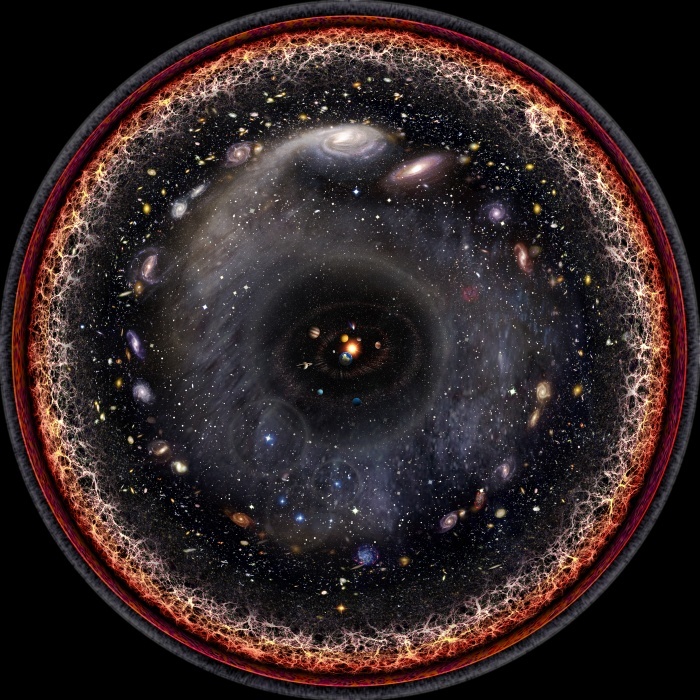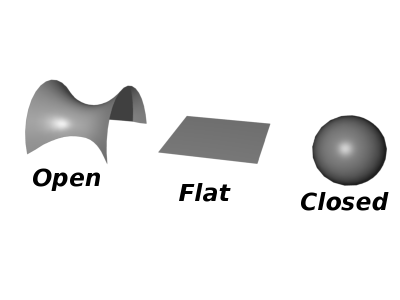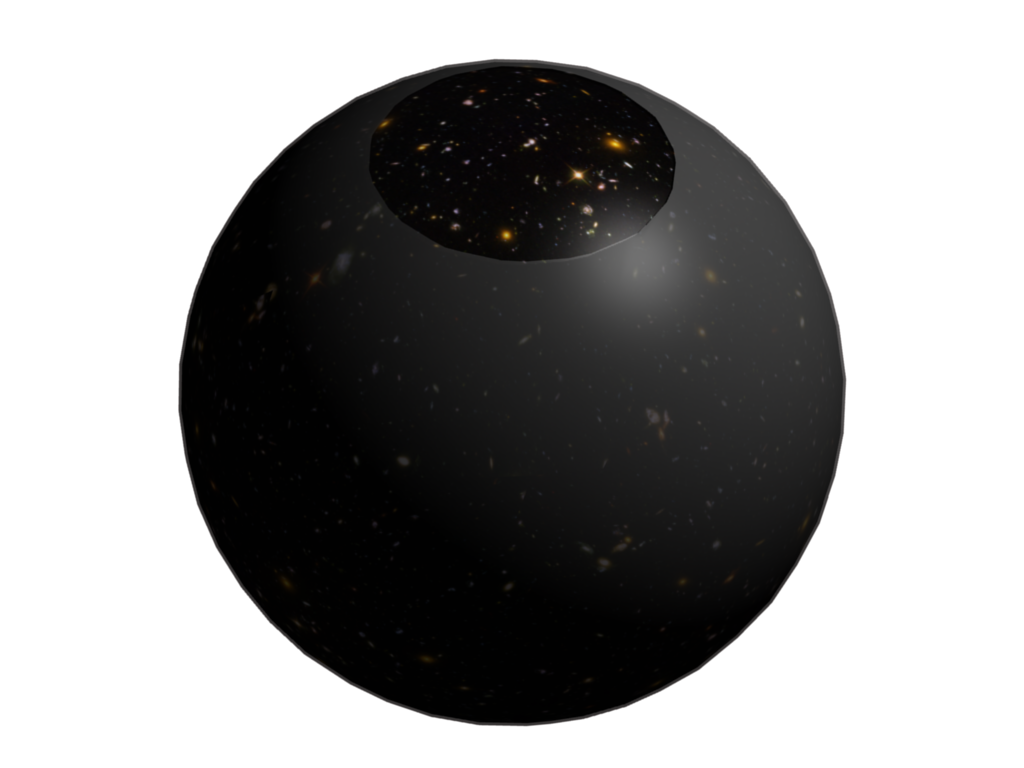The minimum size of the universe
Observable Universe

Speaking of our Universe, we distinguish between the "Universe" and the "observable Universe". The latter includes only what we can see. I do not mean that we have the technology to really “see” the entire observable universe. I mean by “observed” all objects, the light from which, in principle, could reach us, taking into account the lifetime of the Universe, the speed of light and the history and future of the expansion of the Universe. The age of the universe is 13.8 billion years. Because of the finiteness of the speed of light, we cannot see what is so far from us that the light on the journey before us would take more time than the Universe exists. This is not a technological limitation - it is a limitation of whether there is, in principle, the light that we could see if we had any technology at our disposal.
When we look at the outskirts of the observable universe, we look into the past. If it took the world 13.7 billion years to reach us, then we see the Universe as it was 13.7 billion years ago, and not the way it is now.
')
In general, the universe may be infinite. This is easy to state, but this concept is very difficult to imagine, if you think about it. One solution to this problem is to offer not to bother with this. If you ask yourself questions like "how can it expand, if it is infinite," you incorrectly imagine infinity. Infinity is a concept, not a number.
However, the universe does not have to be infinite. According to GR, there are other possibilities. I will divide them into two categories, but we will talk in detail only about one of them.
Interesting topologies
It is possible that the universe has an interesting topology. Topology is different from geometry. Geometry includes such things as the length of lines, the radius of curvature, the sum of the angles of polygons, etc. Topology deals with how different parts of space are interconnected.
Consider, for example, the classic game Asteroids:

The game goes in a very small two-dimensional universe. The geometry of the Asteroids universe is Euclidean — parallel lines do not intersect, the ratio of the circumference to diameter is π, the sum of the three internal angles of the triangle is 180 °, and so on. But if you played this game, you know that if you go beyond the left edge of the screen, you will return from the right edge. If you leave from the top edge, you will return from the bottom. The universe has no boundaries, you will never run into a boundary, or an edge. But it is finite. Its topology is toroidal — the same as the surface of a donut, although its geometry differs from that of a donut (the surface of the donut is curved).
It is possible that our universe behaves in the same way. It may have a flat geometry, but such a topology that if you move in one direction, you will return to where you came from. If it really has such a topology, then it appears on scales larger than the observable Universe. Otherwise, we would see confirmation of such a topology (for example, parts of the cosmos would repeat each other, if we walk for a long time in one direction) in microwave cosmic radiation.
So for now, we assume that the universe has no interesting topologies. Either this is infinite space, or it is a finite space, which is a three-dimensional equivalent of the surface of a sphere.
Possible geometry of the universe
The geometry of the universe does not have to be Euclidean. Depending on the total energy density (including the density of ordinary matter, dark matter and dark energy), there are three possibilities for the curvature of the Universe.

The parameter Ω is a convenient way to discuss the density of the Universe. There is a critical density depending on the current rate of expansion of the Universe. It is 9 * 10 -30 g / cm. It seems to be a bit, but note that the universe is almost empty. Earth is a relatively dense place compared to most of the universe. The parameter Ω is defined as the ratio of the density of the Universe to the critical one. If Ω = 1, then the geometry of the universe is flat. Flat - does not mean two-dimensional, in the sense in which you used to talk about the plane. This means that the geometry of Euclidean space, like the one you studied in school.
If Ω> 1, the geometry of the universe is closed. In this case, the geometry of the Universe will be the same as that of the three-dimensional surface of the four-dimensional hypersphere. If this sounds incomprehensible, imagine it as a three-dimensional equivalent of the surface of a sphere. In this case, the four-dimensional hypersphere does not need to have a fourth spatial dimension. It simply means that the geometry of the Universe — how parallel lines behave, which is equal to the sum of the angles of a triangle, or the ratio of the circumference to diameter — are the same as the geometry on the surface of a sphere. You can describe the math of this geometry using only three spatial dimensions, so higher dimensions may not be needed. However, for the needs of our description, it is worthwhile to imagine the surface of the sphere, since this will help to get an idea of the structure of such a universe. The surface of the sphere is a two-dimensional closed universe. Remember that the universe is a surface. It has no center, it does not exist within the universe - because everything that it contains is located on the surface of the sphere and none of its points is different from the others.
If Ω <1, the geometry of the universe is open. It is more difficult to imagine. A piece of an open three-dimensional universe cannot be crammed into three dimensions for visualization, just as it rolls with a closed universe. However, the closest two-dimensional equivalent would be a saddle or chips (which are hyperboloids, or hyperbolic paraboloids). This is a limitless and infinite universe. It goes on forever. At the same time, it is not flat and it will have an interesting geometry.
Geometry of our universe
The geometry of your universe can be recognized in several ways. For example, you can build in space a triangle of three straight lines. Then you need to measure the angle between each of the pairs of lines. If you fold them and get 180 °, you are in a flat universe. If the amount exceeds 180 °, it will be a closed universe; if it is less than 180 °, it will be an open universe. The only problem is the accuracy of the measurements. Either it is necessary to measure these angles with incredible accuracy, or to draw very large triangles - such that the length of one of its sides approaches the radius of curvature of your universe. (The degree of approximation depends on the accuracy of angle measurement).
In fact, we did it. Measurements of microwave cosmic radiation (MKI) gave us triangles. One side of the triangle is obtained from the characteristic size of fluctuations in the MKI. We know their physical size. Others are derived from the path of light traveling on both sides of this fluctuation. Measuring the angle between the rays of light coming from each side, we can determine the geometry of the triangle. We did it. The answer is: our universe is flat. However, as with any physical quantities, there is an error in our measurements. Judging by the latest calculations , the value of Ω is between 0.9916 and 1.0133, with 95% accuracy. This means that there is still the possibility that our Universe is infinite (Ω≤1) or finite (Ω> 1).
The minimum size of our universe
Cosmos is great. He is just huge. You will not even believe how breathtakingly enormous he is. It may seem to you that it is far from your home to the pharmacy, but this is simply nonsense compared to space.
We apologize to Douglas Adams and calculate the size of our universe.
First, the age of the universe is 13.8 billion years. This is very long compared with our lives, but for the Universe - the age is quite appropriate. The edge of the observable universe is 48 billion light-years away. “Wait a minute!” You can scream. "How can light, in 13.8 billion years, cover a distance of 48 billion light-years!" Remember that for the time when the light came to us, the universe expanded. In a sense, the light was trying to "catch up" expansion. This is an imperfect description and if you know the service station, you will object. But it makes some sense in the context of GR.
How does this size compare with the total size of the universe? If we assume that Ω = 1,0133, and this is the maximum energy density corresponding to the current data, and therefore the smallest of the closed universes, then we can calculate the size of the Universe. The result looks like this:

The surface of a sphere denotes the size of the entire Universe, where Ω = 1,0133. The matte part is outside the Universe we observe; a piece on top - the observable Universe. The radius of curvature of this universe is 120 billion light years. Its circumference is 760 billion light years. This means that the diameter of the observed Universe is 1/8 of the total length of the line, which would have to be held in space so that it closes in on itself. The volume of the entire Universe is 100 times the volume of the observable. (If you object that 8 3 is not equal to 100, remember that space is not Euclidean and your intuition about radii and volumes does not work).
Recall that this is the minimum size of the universe, according to our data. Most suspect that the Universe is really immeasurably larger than this and can be infinite.
Size and fate are not related
Having opened any book on cosmology written before 2000 (and some slightly newer), you will most likely read that the closed universe recollaps, and the open universe is always expanding. But this is so only if the density of the dark energy of the universe is zero! These descriptions implicitly implied that matter dominates in our Universe, and in this case the geometry and the fate of the Universe were strongly connected. In a universe like ours, where dark energy exists, destiny and geometry are not so closely connected. Dark matter and dark energy affect both the shape of the Universe and its fate, but they affect it in different ways. What exactly happens to our Universe depends on what kind of dark energy will be. But if it is the way most of us imagine it, the Universe will expand forever and the galactic clusters will further spread apart from each other. It does not matter if our Universe is flat, open or closed.
Source: https://habr.com/ru/post/396559/
All Articles